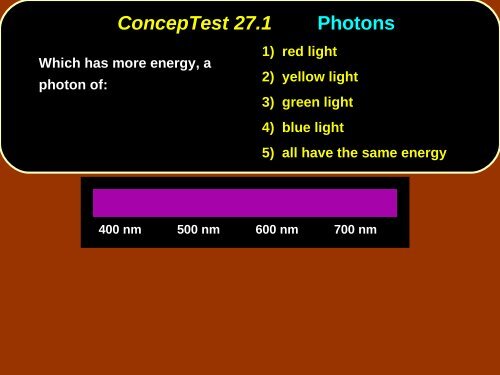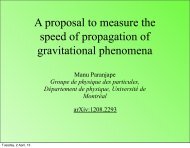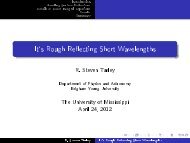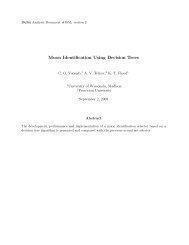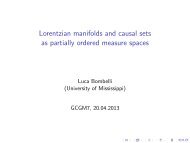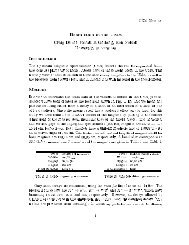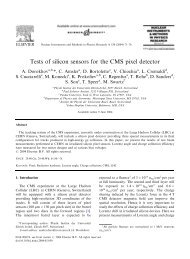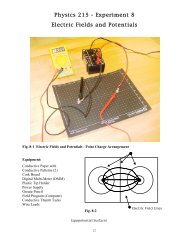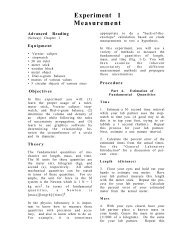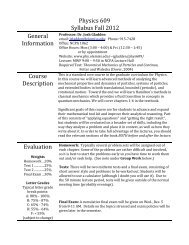Chap. 27 Conceptual Modules Giancoli
Chap. 27 Conceptual Modules Giancoli
Chap. 27 Conceptual Modules Giancoli
Create successful ePaper yourself
Turn your PDF publications into a flip-book with our unique Google optimized e-Paper software.
ConcepTest <strong>27</strong>.1<br />
Photons<br />
Which has more energy, a<br />
photon of:<br />
1) red light<br />
2) yellow light<br />
3) green light<br />
4) blue light<br />
5) all have the same energy<br />
400 nm 500 nm 600 nm 700 nm
ConcepTest <strong>27</strong>.1<br />
Photons<br />
Which has more energy, a<br />
photon of:<br />
E = h f<br />
1) red light<br />
2) yellow light<br />
3) green light<br />
4) blue light<br />
5) all have the same energy<br />
400 nm 500 nm 600 nm 700 nm<br />
The photon with the highest frequency has the most energy<br />
because E = hf = hc/λ (recall that c = f λ). So a higher<br />
frequency corresponds to a lower wavelength. The highest<br />
energy of the above choices is blue.
ConcepTest <strong>27</strong>.2a<br />
If the cutoff frequency for light in<br />
the photoelectric effect for metal<br />
B is greater than that of metal A.<br />
Which metal has a greater work<br />
function?<br />
Photoelectric Effect I<br />
1) metal A<br />
2) metal B<br />
3) same for both<br />
4) W 0<br />
must be zero for one<br />
of the metals<br />
KE<br />
f 0<br />
f
ConcepTest <strong>27</strong>.2a<br />
If the cutoff frequency for light in<br />
the photoelectric effect for metal<br />
B is greater than that of metal A.<br />
Which metal has a greater work<br />
function?<br />
Photoelectric Effect I<br />
1) metal A<br />
2) metal B<br />
3) same for both<br />
4) W 0<br />
must be zero for one<br />
of the metals<br />
A greater cutoff frequency means a higher<br />
energy is needed to knock out the electron. But<br />
this implies that the work function is greater,<br />
since the work function is defined as the<br />
minimum amount of energy needed to eject an<br />
electron.<br />
KE<br />
f 0<br />
f<br />
Follow-up: What would you expect to happen to the work function<br />
of a metal if the metal was heated up?
ConcepTest <strong>27</strong>.2b<br />
A metal surface with a work<br />
function of W 0<br />
= hc/550 nm<br />
is struck with blue light and<br />
electrons are released. If<br />
the blue light is replaced by<br />
red light of the same<br />
intensity, what is the result?<br />
Photoelectric Effect II<br />
1) emitted electrons are more energetic<br />
2) emitted electrons are less energetic<br />
3) more electrons are emitted in a given<br />
time interval<br />
4) fewer electrons are emitted in a<br />
given time interval<br />
5) no electrons are emitted
ConcepTest <strong>27</strong>.2b<br />
A metal surface with a work<br />
function of W 0<br />
= hc/550 nm<br />
is struck with blue light and<br />
electrons are released. If<br />
the blue light is replaced by<br />
red light of the same<br />
intensity, what is the result?<br />
Red light has a wavelength of about 700 nm. The<br />
cutoff wavelength is 550 nm (yellow light), which is<br />
the maximum wavelength to knock out electrons.<br />
Thus, no electrons are knocked out.<br />
high<br />
energy<br />
Photoelectric Effect II<br />
1) emitted electrons are more energetic<br />
2) emitted electrons are less energetic<br />
3) more electrons are emitted in a given<br />
time interval<br />
4) fewer electrons are emitted in a<br />
given time interval<br />
5) no electrons are emitted<br />
E = hc /<br />
λ<br />
low<br />
400 nm 500 nm 600 nm 700 nm
ConcepTest <strong>27</strong>.2c<br />
A metal surface is struck with<br />
light of λ = 400 nm, , releasing<br />
a stream of electrons. If the<br />
400 nm light is replaced by λ<br />
= 300 nm light of the same<br />
intensity, what is the result?<br />
Photoelectric Effect III<br />
1) more electrons are emitted in a given<br />
time interval<br />
2) fewer electrons are emitted in a given<br />
time interval<br />
3) emitted electrons are more energetic<br />
4) emitted electrons are less energetic<br />
5) none of the above
ConcepTest <strong>27</strong>.2c<br />
A metal surface is struck with<br />
light of λ = 400 nm, , releasing<br />
a stream of electrons. If the<br />
400 nm light is replaced by λ<br />
= 300 nm light of the same<br />
intensity, what is the result?<br />
Photoelectric Effect III<br />
1) more electrons are emitted in a given<br />
time interval<br />
2) fewer electrons are emitted in a given<br />
time interval<br />
3) emitted electrons are more energetic<br />
4) emitted electrons are less energetic<br />
5) none of the above<br />
A reduced wavelength means a higher frequency, which<br />
in turn means a higher energy. So the emitted<br />
electrons will be more energetic, since they are now<br />
being hit with higher energy photons.<br />
Remember that c = f λ<br />
and that E = h f
ConcepTest <strong>27</strong>.2d<br />
Photoelectric Effect IV<br />
A metal surface is struck with<br />
light of λ = 400 nm, , releasing<br />
a stream of electrons. If the<br />
light intensity is increased<br />
(without changing λ ), what is<br />
the result?<br />
1) more electrons are emitted in a given<br />
time interval<br />
2) fewer electrons are emitted in a given<br />
time interval<br />
3) emitted electrons are more energetic<br />
4) emitted electrons are less energetic<br />
5) none of the above
ConcepTest <strong>27</strong>.2d<br />
Photoelectric Effect IV<br />
A metal surface is struck with<br />
light of λ = 400 nm, , releasing<br />
a stream of electrons. If the<br />
light intensity is increased<br />
(without changing λ ), what is<br />
the result?<br />
1) more electrons are emitted in a given<br />
time interval<br />
2) fewer electrons are emitted in a given<br />
time interval<br />
3) emitted electrons are more energetic<br />
4) emitted electrons are less energetic<br />
5) none of the above<br />
A higher intensity means a more photons, which in turn<br />
means more electrons. On average, each photon<br />
knocks out one electron.
ConcepTest <strong>27</strong>.2e<br />
A photocell is illuminated with<br />
light with a frequency above the<br />
cutoff frequency. The magnitude<br />
of the current produced depends<br />
on:<br />
Photoelectric Effect V<br />
1) wavelength of the light<br />
2) intensity of the light<br />
3) frequency of the light<br />
4) all of the above<br />
5) none of the above
ConcepTest <strong>27</strong>.2e<br />
A photocell is illuminated with<br />
light with a frequency above the<br />
cutoff frequency. The magnitude<br />
of the current produced depends<br />
on:<br />
Photoelectric Effect V<br />
1) wavelength of the light<br />
2) intensity of the light<br />
3) frequency of the light<br />
4) all of the above<br />
5) none of the above<br />
Each photon can only knock out one<br />
electron. So to increase the current, we<br />
would have to knock out more electrons,<br />
which means we need more photons, which<br />
means we need a greater intensity!<br />
Changing the frequency or wavelength will<br />
change the energy of each electron, but we<br />
are interested in the number of electrons in<br />
this case.
ConcepTest <strong>27</strong>.3a<br />
The speed of proton A is<br />
larger than the speed of<br />
proton B. Which one has<br />
the longer wavelength?<br />
Wave-Particle Duality I<br />
1) proton A<br />
2) proton B<br />
3) both the same<br />
4) neither has a wavelength
ConcepTest <strong>27</strong>.3a<br />
The speed of proton A is<br />
larger than the speed of<br />
proton B. Which one has<br />
the longer wavelength?<br />
Wave-Particle Duality I<br />
1) proton A<br />
2) proton B<br />
3) both the same<br />
4) neither has a wavelength<br />
Remember that<br />
λ = h<br />
mv<br />
so the proton with the<br />
smaller velocity will have the longer wavelength.
ConcepTest <strong>27</strong>.3b<br />
An electron and a proton<br />
have the same speed.<br />
Which has the longer<br />
wavelength?<br />
Wave-Particle Duality II<br />
1) electron<br />
2) proton<br />
3) both the same<br />
4) neither has a wavelength
ConcepTest <strong>27</strong>.3b<br />
An electron and a proton<br />
have the same speed.<br />
Which has the longer<br />
wavelength?<br />
Wave-Particle Duality II<br />
1) electron<br />
2) proton<br />
3) both the same<br />
4) neither has a wavelength<br />
Remember that<br />
λ<br />
= h<br />
mv<br />
and the particles both<br />
have the same velocity, so the particle with the<br />
smaller mass will have the longer wavelength.
ConcepTest <strong>27</strong>.3c<br />
An electron and a proton are<br />
accelerated through the<br />
same voltage. . Which has<br />
the longer wavelength?<br />
Wave-Particle Duality III<br />
1) electron<br />
2) proton<br />
3) both the same<br />
4) neither has a wavelength
ConcepTest <strong>27</strong>.3c<br />
An electron and a proton are<br />
accelerated through the<br />
same voltage. . Which has<br />
the longer wavelength?<br />
Wave-Particle Duality III<br />
1) electron<br />
2) proton<br />
3) both the same<br />
4) neither has a wavelength<br />
Because PE i<br />
= KE f<br />
both particles will get the same<br />
kinetic energy (= 1/2 mv 2 = p 2 /2m). So the lighter<br />
particle (electron) gets the smaller momentum.<br />
Because<br />
λ<br />
= h<br />
mv<br />
the particle with the smaller<br />
momentum will have the longer wavelength.
ConcepTest <strong>27</strong>.3d<br />
An electron and a proton<br />
have the same momentum.<br />
Which has the longer<br />
wavelength?<br />
Wave-Particle Duality IV<br />
1) electron<br />
2) proton<br />
3) both the same<br />
4) neither has a wavelength
ConcepTest <strong>27</strong>.3d<br />
An electron and a proton<br />
have the same momentum.<br />
Which has the longer<br />
wavelength?<br />
Wave-Particle Duality IV<br />
1) electron<br />
2) proton<br />
3) both the same<br />
4) neither has a wavelength<br />
Remember that<br />
λ<br />
= h<br />
mv<br />
and p = mv, so if the<br />
particles have the same momentum, they will also<br />
have the same wavelength.
ConcepTest <strong>27</strong>.4 Ionization<br />
How much energy does it<br />
take to ionize a hydrogen<br />
atom in its ground state?<br />
1) 0 eV<br />
2) 13.6 eV<br />
3) 41.2 eV<br />
4) 54.4 eV<br />
5) 108.8 eV
ConcepTest <strong>27</strong>.4<br />
How much energy does it<br />
take to ionize a hydrogen<br />
atom in its ground state?<br />
Ionization<br />
1) 0 eV<br />
2) 13.6 eV<br />
3) 41.2 eV<br />
4) 54.4 eV<br />
5) 108.8 eV<br />
The energy of the ground state is the<br />
energy that binds the electron to the<br />
nucleus. Thus, an amount equal to this<br />
binding energy must be supplied in order<br />
E n<br />
=<br />
E<br />
1<br />
Z<br />
n<br />
2<br />
2<br />
to kick the electron out of the atom.<br />
Follow-up: How much energy does it take to change a He + ion<br />
into a He ++ ion? Keep in mind that Z = 2 for helium.
ConcepTest <strong>27</strong>.5a<br />
For the possible transitions<br />
shown, for which transition will<br />
the electron gain the most<br />
energy?<br />
Atomic Transitions I<br />
1) 2 → 5<br />
2) 5 → 3<br />
3) 8 → 5<br />
4) 4 → 7<br />
5) 15 → 7<br />
n = 5<br />
n = 4<br />
n = 3<br />
n = 2<br />
n = 1
ConcepTest <strong>27</strong>.5a<br />
For the possible transitions<br />
shown, for which transition will<br />
the electron gain the most<br />
energy?<br />
Atomic Transitions I<br />
1) 2 → 5<br />
2) 5 → 3<br />
3) 8 → 5<br />
4) 4 → 7<br />
5) 15 → 7<br />
The electron must go to a higher orbit<br />
(higher<br />
n) in order for the electron to<br />
gain energy.<br />
Because of the 1/n 2 dependence:<br />
n = 5<br />
n = 4<br />
n = 3<br />
n = 2<br />
E 2<br />
– E 5<br />
> E 4<br />
– E 7<br />
n = 1<br />
Follow-up: Which transition will emit the shortest wavelength photon?
ConcepTest <strong>27</strong>.5b<br />
The Balmer series for hydrogen<br />
can be observed in the visible part<br />
of the spectrum. Which transition<br />
leads to the reddest line in the<br />
spectrum?<br />
Atomic Transitions II<br />
1) 3 → 2<br />
2) 4 → 2<br />
3) 5 → 2<br />
4) 6 → 2<br />
5) ∞ → 2<br />
n = ∞<br />
n = 6<br />
n = 5<br />
n = 4<br />
n = 3<br />
n = 2<br />
n = 1
ConcepTest <strong>27</strong>.5b<br />
The Balmer series for hydrogen<br />
can be observed in the visible part<br />
of the spectrum. Which transition<br />
leads to the reddest line in the<br />
spectrum?<br />
The transition 3 → 2 has the<br />
lowest energy and thus the lowest<br />
frequency photon, which<br />
corresponds to the longest<br />
wavelength (and therefore the<br />
“reddest”) line in the spectrum.<br />
Atomic Transitions II<br />
1) 3 → 2<br />
2) 4 → 2<br />
3) 5 → 2<br />
4) 6 → 2<br />
5) ∞ → 2<br />
n = ∞<br />
n = 6<br />
n = 5<br />
n = 4<br />
n = 3<br />
n = 2<br />
n = 1<br />
Follow-up: Which transition leads to the shortest wavelength photon?
ConcepTest <strong>27</strong>.6<br />
Balmer Series<br />
When a broad spectrum of<br />
light passes through<br />
hydrogen gas at room<br />
temperature, absorption lines<br />
are observed that correspond<br />
only to the Balmer (n f<br />
= 2)<br />
series. Why aren’t other<br />
series observed?<br />
1) they’re there, but they’re invisible<br />
2) only the Balmer series can be<br />
excited at room temperature<br />
3) the other series have been ionized<br />
4) all the photons have been used up
ConcepTest <strong>27</strong>.6<br />
Balmer Series<br />
When a broad spectrum of<br />
light passes through<br />
hydrogen gas at room<br />
temperature, absorption lines<br />
are observed that correspond<br />
only to the Balmer (n f<br />
= 2)<br />
series. Why aren’t other<br />
series observed?<br />
1) they’re there, but they’re invisible<br />
2) only the Balmer series can be<br />
excited at room temperature<br />
3) the other series have been ionized<br />
4) all the photons have been used up<br />
The Balmer series is the only one<br />
that involves wavelengths in the<br />
visible part of the spectrum!<br />
Follow-up: From the diagram at right,<br />
where in the EM spectrum is the<br />
Lyman series located?
ConcepTest <strong>27</strong>.7a<br />
Suppose there is an atom that<br />
contains exactly five energy<br />
levels. How many different<br />
transitions are possible? (Count<br />
only one direction!)<br />
Energy Levels I<br />
1) 4<br />
2) 5<br />
3) 10<br />
4) 20<br />
5) many more than 20<br />
n = 5<br />
n = 4<br />
n = 3<br />
n = 2<br />
n = 1
ConcepTest <strong>27</strong>.7a<br />
Suppose there is an atom that<br />
contains exactly five energy<br />
levels. How many different<br />
transitions are possible? (Count<br />
only one direction!)<br />
Energy Levels I<br />
1) 4<br />
2) 5<br />
3) 10<br />
4) 20<br />
5) many more than 20<br />
Just count them! Transitions upward:<br />
n = 1 → n = ?<br />
n = 2 → n = ?<br />
n = 3 → n = ?<br />
n = 4 → n = ?<br />
4 transitions<br />
3 transitions<br />
2 transitions<br />
1 transition<br />
This gives a total of 10 possible ones.<br />
n = 5<br />
n = 4<br />
n = 3<br />
n = 2<br />
n = 1
ConcepTest <strong>27</strong>.7b<br />
Energy Levels II<br />
The emission spectrum for the atoms of a gas is shown. Which of<br />
the energy level diagrams below corresponds to this spectrum?<br />
(1) (2) (3) (4)
ConcepTest <strong>27</strong>.7b<br />
Energy Levels II<br />
The emission spectrum for the atoms of a gas is shown. Which of<br />
the energy level diagrams below corresponds to this spectrum?<br />
(1) (2) (3) (4)<br />
Each line in the spectrum corresponds to a transition between energy<br />
levels! Since there are 6 transitions shown, there must be 4 levels.<br />
The 2 transitions between the closely spaced levels have less energy,<br />
while the other 4 have larger energies.
ConcepTest <strong>27</strong>.8<br />
Rutherford Model<br />
Suppose the Rutherford<br />
model was correct<br />
(instead of the Bohr<br />
model). What would the<br />
absorption spectrum of a<br />
hydrogen atom look like?<br />
1) there would be no change<br />
2) the absorption lines would be broader<br />
3) it would be completely black<br />
4) the absorption lines would be shifted<br />
5) the absorption lines would be bright<br />
instead of dark
ConcepTest <strong>27</strong>.8<br />
Rutherford Model<br />
Suppose the Rutherford<br />
model was correct<br />
(instead of the Bohr<br />
model). What would the<br />
absorption spectrum of a<br />
hydrogen atom look like?<br />
1) there would be no change<br />
2) the absorption lines would be broader<br />
3) it would be completely black<br />
4) the absorption lines would be shifted<br />
5) the absorption lines would be bright<br />
instead of dark<br />
In the Rutherford model, all orbits are allowed for the<br />
electrons. Thus, the atom would be able to absorb all<br />
wavelengths of light instead of only the specific ones<br />
allowed in the Bohr model.


